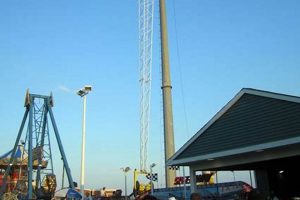A “skinny skyscraper” is a modern architectural style characterized by super-tall structures with a slender, rectangular footprint. These buildings often have a height-to-width ratio of 10:1 or more, giving them a distinctive, pencil-thin appearance. Unlike traditional skyscrapers, which prioritize floor space, skinny skyscrapers emphasize height and verticality, creating an iconic presence in the urban landscape.
The appeal of skinny skyscrapers lies in their unique advantages. Their narrow profile reduces wind resistance, making them more efficient and eco-friendly. They also maximize natural light and offer panoramic views for occupants. Additionally, their slender form allows for innovative designs and distinctive architectural expressions, pushing the boundaries of engineering and aesthetics.
The history of skinny skyscrapers can be traced back to the early 20th century, with the construction of the Flatiron Building in New York City. However, it was not until the 21st century that this architectural style gained widespread popularity, with iconic examples such as the Burj Khalifa in Dubai and the Shanghai Tower in China. Today, skinny skyscrapers continue to redefine city skylines worldwide, becoming symbols of innovation, sustainability, and architectural prowess.
1. Height
Height is a defining characteristic of skinny skyscrapers. Their super-tall structures, often exceeding 300 meters, give them a distinctive and iconic presence in the urban landscape. This extreme height is a result of several factors:
- Land scarcity: In densely populated urban areas, land is a valuable commodity. Skinny skyscrapers allow developers to maximize the use of limited land space by building upwards.
- Engineering advancements: Advances in structural engineering and construction techniques have made it possible to construct buildings of unprecedented height.
- Economic drivers: Tall buildings can generate higher rental income and property values, making them attractive investments for developers.
The height of skinny skyscrapers is not merely a matter of aesthetics. It also has practical implications:
- Panoramic views: The height of skinny skyscrapers offers occupants unparalleled panoramic views of the surrounding city.
- Reduced wind resistance: The slender profile of skinny skyscrapers reduces wind resistance, making them more efficient and eco-friendly.
- Vertical transportation: Super-tall buildings require sophisticated vertical transportation systems, such as high-speed elevators, to efficiently move occupants between floors.
In conclusion, the height of skinny skyscrapers is a defining characteristic that stems from a combination of land scarcity, engineering advancements, and economic drivers. It not only contributes to their iconic presence but also offers practical benefits such as panoramic views, reduced wind resistance, and efficient vertical transportation.
2. Slenderness
The slenderness of skinny skyscrapers is a key characteristic that sets them apart from traditional skyscrapers. Their narrow profile, often with a height-to-width ratio of 10:1 or more, gives them a distinctive, pencil-thin appearance. This slenderness is not merely a matter of aesthetics; it is integral to the structural integrity and overall design of skinny skyscrapers.
The slender profile of skinny skyscrapers reduces wind resistance, making them more efficient and eco-friendly. The aerodynamic shape minimizes the impact of wind forces, reducing structural sway and energy consumption. This efficiency is particularly important in high-rise buildings, where wind loads can be significant.
Moreover, the slenderness of skinny skyscrapers allows for innovative designs and distinctive architectural expressions. The narrow footprint provides architects with a unique canvas to create visually striking structures that push the boundaries of engineering and aesthetics. For example, the Burj Khalifa in Dubai features a spiraling exterior that tapers towards the top, creating a dynamic and iconic silhouette.
In conclusion, the slenderness of skinny skyscrapers is not just a visual characteristic but a crucial component that contributes to their structural efficiency, sustainability, and architectural appeal. By reducing wind resistance and enabling innovative designs, the slender profile of skinny skyscrapers has revolutionized modern architecture and continues to shape the skylines of major cities worldwide.
3. Efficiency
Skinny skyscrapers are designed with an aerodynamic shape to reduce wind resistance, contributing to their overall efficiency and environmental friendliness. This aerodynamic design offers several key benefits:
- Reduced structural sway: The streamlined shape of skinny skyscrapers minimizes the impact of wind forces, reducing structural sway and enhancing the stability of the building.
- Lower energy consumption: By reducing wind resistance, skinny skyscrapers require less energy for heating and cooling, resulting in lower operating costs and a reduced carbon footprint.
- Improved occupant comfort: Reduced wind resistance leads to less building sway, which can cause discomfort for occupants, especially at higher floors.
- Sustainable design: The energy efficiency and reduced carbon footprint of skinny skyscrapers align with sustainable building practices, promoting environmental conservation.
In conclusion, the aerodynamic shape of skinny skyscrapers contributes to their efficiency and eco-friendliness. By reducing wind resistance, these buildings enhance structural stability, lower energy consumption, improve occupant comfort, and support sustainable design principles, making them a valuable addition to modern architecture.
4. Views
The panoramic views offered by skinny skyscrapers are a direct result of their unique height and narrow footprint. The extreme height of these buildings elevates occupants far above the ground, providing breathtaking vistas of the surrounding cityscape and natural landscapes. Moreover, the slender profile of skinny skyscrapers minimizes obstructions to views, allowing for expansive windows that maximize natural light and offer unobstructed sightlines.
The importance of panoramic views in skinny skyscrapers extends beyond aesthetics. Natural light has been proven to enhan
ce occupant well-being, productivity, and overall quality of life. The abundance of natural light in skinny skyscrapers not only creates a more pleasant and inviting living or working environment but also reduces the need for artificial lighting, contributing to energy efficiency.
Real-life examples of skinny skyscrapers with exceptional views include the One World Trade Center in New York City, which offers stunning panoramic views of the Manhattan skyline and the Hudson River from its upper floors. The Burj Khalifa in Dubai, the tallest building in the world, provides breathtaking views of the Arabian Gulf and the surrounding desert landscape. These examples showcase the transformative power of panoramic views in enhancing theexperience and creating a sense of connection with the surrounding environment.
In conclusion, the panoramic views offered by skinny skyscrapers are a key component of their design and appeal. The combination of extreme height and narrow footprint allows occupants to enjoy unparalleled vistas, maximizing natural light and enhancing overall well-being. Understanding this connection is crucial for appreciating the unique value and desirability of skinny skyscrapers in modern architecture.
5. Innovation
Skinny skyscrapers, with their extreme height and slender profile, have become a testament to the ingenuity and innovation of modern architecture. They have pushed the boundaries of engineering and design, resulting in iconic structures that redefine city skylines and offer unique experiences for occupants.
- Structural Innovations
Skinny skyscrapers require innovative structural solutions to withstand the challenges of height and wind resistance. Engineers have developed advanced systems, such as diagrid structures and outrigger systems, to ensure stability and minimize sway. These innovations enable the creation of super-tall buildings with a slender profile. - Facade Design
The facades of skinny skyscrapers play a crucial role in managing wind loads and maximizing natural light. Architects have developed advanced glazing systems and shading devices that reduce wind resistance while allowing for expansive views. These facades not only enhance the aesthetics of the building but also contribute to its overall efficiency. - Vertical Transportation
Super-tall skinny skyscrapers require sophisticated vertical transportation systems to efficiently move occupants and visitors. Engineers have developed high-speed elevators with advanced control systems and multiple cabins to minimize wait times and optimize building operations. - Sustainability Features
Skinny skyscrapers often incorporate sustainable design features to reduce their environmental impact. These features may include energy-efficient lighting systems, rainwater harvesting systems, and green roofs. By embracing sustainability, skinny skyscrapers contribute to a greener and more sustainable built environment.
In conclusion, the innovation inherent in skinny skyscrapers extends beyond their height and slenderness. It encompasses a wide range of engineering and design advancements that address structural stability, facade design, vertical transportation, and sustainability. These innovations have enabled the creation of iconic structures that redefine the possibilities of modern architecture.
6. Urban Impact
The urban impact of skinny skyscrapers is undeniable. These super-tall, slender structures have become iconic landmarks in cities around the world, reshaping skylines and serving as symbols of progress and architectural prowess. The unique characteristics of skinny skyscrapers contribute directly to their transformative impact on the urban landscape.
The extreme height of skinny skyscrapers allows them to dominate the skyline, creating a striking visual presence. Their slender profile, often with a height-to-width ratio of 10:1 or more, gives them a distinctive, pencil-thin appearance that sets them apart from traditional skyscrapers. This striking design not only enhances the aesthetic appeal of the city but also serves as a testament to the engineering and architectural advancements that have made such structures possible.
Beyond their visual impact, skinny skyscrapers have become symbols of progress and architectural prowess. Their construction often coincides with periods of economic growth and development, representing the aspirations and ambitions of a city or nation. For example, the Burj Khalifa in Dubai, the tallest building in the world, stands as a symbol of the city’s rapid growth and transformation into a global metropolis. Similarly, the Shanghai Tower in China represents the country’s economic and technological advancements.
The urban impact of skinny skyscrapers extends beyond their symbolic value. They can also have a positive impact on the surrounding environment and urban fabric. By concentrating density in a vertical format, skinny skyscrapers can help to reduce urban sprawl and preserve valuable land resources. Additionally, their energy-efficient design and use of natural light can contribute to a more sustainable and environmentally friendly urban environment.
Understanding the connection between skinny skyscrapers and their urban impact is crucial for architects, urban planners, and policymakers. It helps to inform decision-making processes related to the design, construction, and regulation of these iconic structures. By considering the urban impact of skinny skyscrapers, cities can ensure that these buildings contribute positively to the overall urban environment and serve as symbols of progress and architectural prowess for generations to come.
7. Sustainability
Skinny skyscrapers, with their innovative designs and emphasis on natural light, are at the forefront of sustainable architecture. Their unique characteristics contribute to several facets of sustainability, including energy efficiency, reduced carbon footprint, and occupant well-being.
- Energy Efficiency
The aerodynamic shape of skinny skyscrapers reduces wind resistance, minimizing energy consumption for heating and cooling. Additionally, their use of natural light through expansive windows reduces the need for artificial lighting, further enhancing energy efficiency.
- Reduced Carbon Footprint
The energy-efficient design of skinny skyscrapers directly contributes to a reduced carbon footprint. By consuming less energy, they release fewer greenhouse gases into the atmosphere, mitigating their environmental impact.
- Occupant Well-being
Natural light has been proven to have numerous benefits for occupant well-being. Skinny skyscrapers, with their abundance of natural light, promote a healthier indoor environment, reducing eye strain, improving mood, and enhancing overall productivity.
In conclusion, the sustainability of skinny skyscrapers is directly tied to their efficient design and use of natural light. These factors contribute to energy efficiency, reduce the carbon footprint, and enhance occupant well-being, making skinny skyscrapers a sustainable choice for mode
rn architecture and urban development.
Frequently Asked Questions about Skinny Skyscrapers
This section addresses common concerns and misconceptions about skinny skyscrapers, providing concise and informative answers to enhance understanding.
Question 1: Are skinny skyscrapers safe and stable despite their slender appearance?
Yes, skinny skyscrapers are designed to be safe and stable despite their slender profile. Advanced engineering techniques, such as diagrid structures and outrigger systems, are employed to ensure structural integrity and minimize sway. These buildings undergo rigorous testing and meet strict building codes to withstand high winds and seismic activity.
Question 2: How do skinny skyscrapers address the challenges of wind resistance?
Skinny skyscrapers are designed with aerodynamic shapes to reduce wind resistance. Their streamlined profile minimizes the impact of wind forces, reducing structural sway and enhancing overall stability. Additionally, advanced facade systems and wind baffles are incorporated to further mitigate wind loads.
Question 3: Do skinny skyscrapers provide adequate natural light and views for occupants?
Yes, skinny skyscrapers are designed to maximize natural light and views. Expansive windows and efficient floor plans allow ample daylight to penetrate deep into the building, reducing the need for artificial lighting. Additionally, the height and narrow footprint of these buildings offer panoramic views of the surrounding cityscape and natural landscapes.
Question 4: Are skinny skyscrapers energy-efficient and sustainable?
Skinny skyscrapers often incorporate sustainable design features to reduce their environmental impact. Energy-efficient lighting systems, rainwater harvesting systems, and green roofs are common features. Their aerodynamic shape and use of natural light contribute to reduced energy consumption and a lower carbon footprint.
Question 5: How do skinny skyscrapers impact the urban environment?
Skinny skyscrapers can have a significant impact on the urban environment. Their height and unique design create iconic landmarks and redefine city skylines. By concentrating density in a vertical format, they can help reduce urban sprawl and preserve valuable land resources.
Question 6: What are the key advantages and disadvantages of skinny skyscrapers?
Advantages:
- Distinctive architectural presence and iconic landmarks
- Reduced wind resistance and structural efficiency
- Maximized natural light and panoramic views
- Sustainable design features and energy efficiency
- Efficient use of land resources
Disadvantages:
- Higher construction costs compared to traditional skyscrapers
- Potential for limited floor space and smaller floor plates
- Need for advanced engineering solutions and specialized construction techniques
In summary, skinny skyscrapers are innovative architectural marvels that combine engineering prowess with sustainable design principles. They offer unique advantages while addressing challenges related to wind resistance, natural light, and urban impact. Understanding these aspects is key to appreciating the significance and complexities of skinny skyscrapers in modern architecture and urban development.
Transition to the next article section:
This comprehensive overview of skinny skyscrapers provides valuable insights into their design, benefits, and challenges. As architectural innovation continues to push boundaries, we can expect to see further advancements in the design and construction of these iconic structures.
Tips for Designing and Constructing Skinny Skyscrapers
Skinny skyscrapers present unique challenges and opportunities for architects, engineers, and developers. Here are some key tips to consider when designing and constructing these iconic structures:
Tip 1: Prioritize Structural Stability
Given their slender profile, ensuring structural stability is paramount. Employ advanced engineering techniques like diagrid structures and outrigger systems to distribute wind loads effectively and minimize sway.
Tip 2: Optimize Aerodynamic Design
To reduce wind resistance, incorporate aerodynamic design principles into the building’s shape. Streamlined profiles and wind baffles will help mitigate lateral forces and enhance overall stability.
Tip 3: Maximize Natural Light and Views
Maximize natural light penetration and panoramic views by using expansive windows and efficient floor plans. Large windows will reduce the need for artificial lighting, while well-positioned windows will offer stunning vistas for occupants.
Tip 4: Embrace Sustainable Features
Incorporate sustainable design features such as energy-efficient lighting systems, rainwater harvesting systems, and green roofs to reduce the building’s environmental impact and promote occupant well-being.
Tip 5: Consider Wind Impact on Facade Design
Design the building’s facade to withstand wind loads effectively. Use durable materials, incorporate wind baffles, and conduct wind tunnel testing to optimize facade performance and minimize wind-induced vibrations.
Tip 6: Address Potential Sway Issues
Implement measures to address potential sway caused by wind forces. This may include using tuned mass dampers, active control systems, or optimizing the building’s shape to reduce wind-induced resonance.
Tip 7: Ensure Efficient Vertical Transportation
Provide efficient vertical transportation systems to move occupants quickly and safely between floors. Consider high-speed elevators with multiple cabins and advanced control systems to minimize wait times.
Tip 8: Collaborate with Experts
Collaborate with experienced architects, engineers, and contractors who specialize in the design and construction of skinny skyscrapers. Their expertise will ensure that the building meets all safety, structural, and aesthetic requirements.
By following these tips, architects, engineers, and developers can create skinny skyscrapers that are not only visually striking but also structurally sound, sustainable, and enjoyable for occupants.
Key Takeaways
- Skinny skyscrapers require innovative engineering solutions to ensure structural stability and minimize wind resistance.
- Maximizing natural light and views enhances occupant well-being and reduces energy consumption.
- Sustainable design features can significantly reduce the environmental impact of skinny skyscrapers.
- Collaboration between experts is crucial for successful design and construction.
As skinny skyscrapers continue to redefine skylines worldwide, these tips will guide architects, engineers, and developers in creating iconic structures that meet the challenges and opportunities of high-rise construction.
Conclusion
Skinny skyscrapers, with their extreme height and slender profile, have emerged as iconic symbols of architectural innovation and urban progress. Their unique design challenges have driven advancements in engineering, sustainability, and occupant well-being.
The key to understanding skinny skyscrapers lies in their ability to reconcile seemingly contradictory elements. They combine architectural audacity with structural stability, energy efficiency with breathtaking views, and urban density with reduced land use. This delicate balance has made skinny skyscrapers a marvel of modern architecture.
As cities continue to grow vertically, skinny skyscrape
rs will undoubtedly play a significant role in shaping future skylines. Their ability to maximize space, reduce environmental impact, and enhance occupant experience makes them a valuable addition to the urban fabric. By embracing innovation and collaboration, architects, engineers, and developers can continue to push the boundaries of skinny skyscraper design, creating structures that are both visually striking and functionally exceptional.







